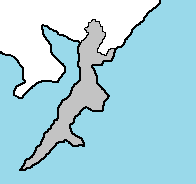San Martina
Republic of San Martina | |
|---|---|
|
Flag | |
 | |
| Capital | Samari City |
| Government | |
| Cardalo Cappellacci | |
| Population | |
• 2020 estimate | 4,029,000 |
| Date format | mm-dd-yyyy |
The Republic of San Martina, most commonly known as San Martina, is a nation in the Coalition of Crown Albatross located on the continent of Adula, bordered by Verdusa. Its capital and largest city is Samari, with other major towns including Santa Gallura and Assemini. Eighty percent of San Martina is mountainous, with Mount Martina being the highest peak at 2,348 meters. Owing to the variety of San Martina's ecosystems, which include mountains, woods, plains, stretches of largely uninhabited territory, streams, rocky coasts, and long sandy beaches, the nation is often referred to as its own unique environment. In the modern era, many travelers and writers have extolled the beauty of its long-untouched landscapes, which retain vestiges of the ancient Emmirian civilization.
The country derives its name from Saint Martinas, a stonemason from the Verdusan colony on the island of Riana. The country's economy mainly relies on finance, casino industries, services and tourism. It is one of the wealthiest countries in the world in terms of GDP per capita, with a figure comparable to the most developed Adula regions. San Martina is considered to have a highly stable economy, with one of the lowest unemployment rates in Adula, no national debt and a budget surplus. San Martina is a member of multiple international organizations, including WEDA, SEIAA, the CTO, and the CCA.
History

Geography
The coasts of San Martina are 1,849 km (1,149 mi) long. They are generally high and rocky, with long, relatively straight stretches of coastline, many outstanding headlands, a few wide, deep bays, rias, many inlets and with various smaller islands off the coast. San Martina has few major rivers, the largest being the Sirso, 151 km (94 mi) long, which flows into the Haifan Sea. There are 54 artificial lakes and dams that supply water and electricity. The main ones are Lake Midea and Lake Gennea. The only natural freshwater lake is Lago di Bara. A number of large, shallow, salt-water lagoons and pools are located along the coastline.
The climate of the nation is variable from area to area, due to several factors including the extension in latitude and the elevation. It can be classified in two different macrobioclimates (Pluviseasonal oceanic and Temperate oceanic), one macrobioclimatic variant (Suboceanic), and four classes of continentality (from weak semihyperoceanic to weak semicontinental). During the year there is a major concentration of rainfall in the winter and autumn, some heavy showers in the spring and snowfalls in the highlands. The average temperature is between 11 to 17 °C (52 to 63 °F), with mild winters and warm summers on the coasts (9 to 11 °C (48 to 52 °F) in July, 23 to 26 °C (73 to 79 °F) in January), and cold winters and cool summers on the mountains (−2 to 4 °C (28 to 39 °F) in July, 16 to 20 °C (61 to 68 °F) in January).


